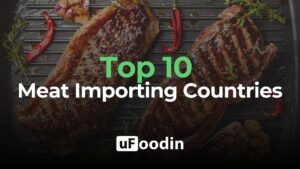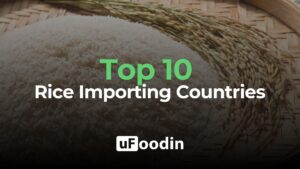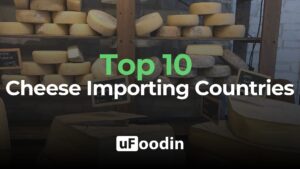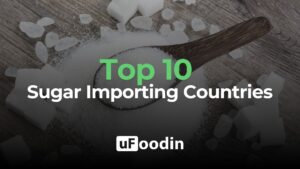
Top 10 Meat Importing Countries
The global meat market continues to thrive, fueled by rising demand for protein-rich diets and growing consumption across developed and emerging economies. In 2023, the global meat import market was valued at approximately $70 billion, with the top 10 importing countries accounting for over 60% of total imports. These markets include both established players like the United States and Japan, and rapidly growing economies such as China and South Korea.
Global meat consumption is projected to grow at a CAGR of 3.6%, driven by urbanization, rising disposable incomes, and an increasing focus on dietary diversity. However, the industry faces challenges such as sustainability concerns, rising production costs, and shifting consumer preferences toward alternative proteins. This article explores the Top 10 Meat Importing Countries, highlighting key trends and opportunities for exporters looking to target these markets.

1. China
- Import Volume: Over 7.4 million tons annually
- Value of Imports: Approximately $28 billion (2023)
- Why It Stands Out: China is the world’s largest importer of meat, driven by demand for pork, beef, and poultry to meet the needs of its large population.
- Key Insights: African swine fever outbreaks have significantly increased the country’s reliance on imported pork, while demand for high-quality beef continues to rise.
2. Japan
- Import Volume: Around 2.8 million tons annually
- Value of Imports: Approximately $12 billion (2023)
- Why It Stands Out: Japan imports a wide variety of meat, particularly premium beef, due to its limited domestic production capacity.
- Key Insights: Japanese consumers are willing to pay a premium for grain-fed beef and Wagyu alternatives, with imports primarily sourced from Australia and the U.S.
3. United States
- Import Volume: Over 2.6 million tons annually
- Value of Imports: Approximately $11 billion (2023)
- Why It Stands Out: The U.S. is both a major exporter and importer of meat, importing primarily grass-fed beef and specialty meats.
- Key Insights: Imports cater to diverse consumer preferences, particularly for products not widely produced domestically, such as lamb and certain seafood proteins.
4. South Korea
- Import Volume: Around 2.1 million tons annually
- Value of Imports: Approximately $9 billion (2023)
- Why It Stands Out: South Korea’s growing preference for beef and pork, fueled by Western dining trends, makes it one of the fastest-growing meat import markets.
- Key Insights: High-quality cuts of beef, particularly from Australia and the U.S., dominate imports.
5. Germany
- Import Volume: Over 1.9 million tons annually
- Value of Imports: Approximately $8 billion (2023)
- Why It Stands Out: As Europe’s largest economy, Germany imports significant quantities of pork and poultry for its domestic and industrial markets.
- Key Insights: Sustainability and ethical sourcing are key considerations for German consumers.
6. United Kingdom
- Import Volume: Around 1.7 million tons annually
- Value of Imports: Approximately $7 billion (2023)
- Why It Stands Out: The UK imports a diverse range of meats, particularly beef and lamb, to cater to its multicultural population.
- Key Insights: Post-Brexit trade agreements have reshaped the UK’s sourcing dynamics, opening doors for non-EU exporters.
7. Mexico
- Import Volume: Over 1.5 million tons annually
- Value of Imports: Approximately $6 billion (2023)
- Why It Stands Out: Mexico’s growing middle class and its affinity for beef and poultry have made it a key meat import market.
- Key Insights: Imports cater to both domestic consumption and the country’s robust foodservice sector.
8. France
- Import Volume: Around 1.3 million tons annually
- Value of Imports: Approximately $5 billion (2023)
- Why It Stands Out: France imports meat to supplement its robust domestic production, particularly for pork and specialty meats.
- Key Insights: French consumers prioritize quality and origin, favoring organic and sustainable options.
9. Italy
- Import Volume: Over 1.1 million tons annually
- Value of Imports: Approximately $4.5 billion (2023)
- Why It Stands Out: Italy’s meat imports cater to both domestic consumption and its thriving processed food industry.
- Key Insights: The demand for premium beef and specialty cured meats remains high.
10. Saudi Arabia
- Import Volume: Around 1 million tons annually
- Value of Imports: Approximately $4 billion (2023)
- Why It Stands Out: Saudi Arabia relies heavily on imported meat due to limited domestic production, with strong demand for halal-certified products.
- Key Insights: Poultry and lamb dominate imports, with suppliers needing to meet strict religious and quality standards.
Trends in Meat Imports
- Premiumization and Quality Assurance:
Consumers in developed markets are increasingly seeking premium and high-quality meats, such as grain-fed beef and organic poultry. - Halal and Kosher Certifications:
Demand for certified meats is rising, particularly in the Middle East and Jewish communities worldwide. - Sustainability in Meat Production:
Ethical sourcing and reduced environmental impact are becoming key purchasing factors, particularly in Europe and North America. - Health-Conscious Products:
Leaner cuts and grass-fed options are gaining popularity, aligning with the global health and wellness trend. - Asia’s Growing Appetite:
Emerging markets in Asia, particularly China and South Korea, are driving demand for high-quality and diverse meat imports. - E-Commerce and Digital Platforms:
Online retailing is making imported meats more accessible to consumers, particularly in urban markets.

Challenges in the Meat Industry
- Sustainability and Climate Impact:
The meat industry faces criticism for its environmental footprint, pushing producers to adopt greener practices. - Regulatory and Trade Barriers:
Tariffs, import quotas, and sanitary regulations create obstacles for exporters in navigating international markets. - Rising Costs and Inflation:
Increased costs for feed, labor, and logistics are impacting pricing and profitability in the meat trade. - Competition from Plant-Based Alternatives:
The growing popularity of plant-based and lab-grown meats poses a long-term challenge to traditional meat products. - Animal Welfare Concerns:
Ethical considerations regarding livestock treatment are influencing consumer preferences in developed markets. - Supply Chain Disruptions:
The COVID-19 pandemic and geopolitical tensions continue to create logistical hurdles for exporters.
The Top 10 Meat Importing Countries highlight the immense opportunities available to global meat producers. From China’s insatiable demand for pork to Saudi Arabia’s reliance on halal-certified imports, each market presents unique dynamics and growth potential.
Platforms like uFoodin are empowering producers to connect with importers across 210+ countries, streamlining access to diverse markets. With tools for showcasing products, monitoring trends, and establishing partnerships, uFoodin equips suppliers with the insights and resources needed to navigate a competitive and evolving industry.
As sustainability, health consciousness, and consumer preferences reshape global meat markets, adaptability and innovation will be key. By leveraging platforms like uFoodin, producers can secure long-term success, address emerging challenges, and capitalize on the growing demand for high-quality, ethically sourced meat.
uFoodin Editorial Team
Bibliography
- Statista: Global Meat Import Market Overview
- International Meat Secretariat: Trade and Consumption Data
- Reuters: Trends in Asian Meat Markets
- MarketWatch: Growth in Premium Meat Segments
- USDA Foreign Agricultural Service: Meat Trade Reports
- Mordor Intelligence: Global Meat Industry Challenges and Forecasts




















